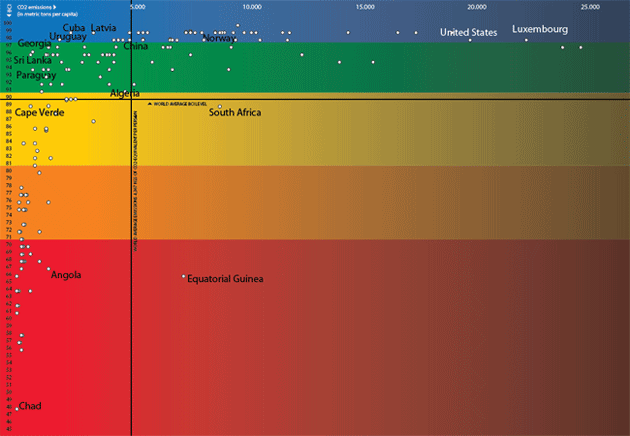The virtuous few: clean and dignified
Published on Thu, 2011-10-13 17:00
What do Costa Rica, Uruguay and Georgia (the country in the Caucasus, not the American state) have in common? They all have achieved high positions in their social indicators while keeping their emissions of climate changing carbon dioxide at less than half of the global per capita average. A couple dozen countries perform a little better than these three in the Basic Capabilities Index published today by the watchdog organization Social Watch, on the eve of the international days on hunger and poverty. One out of four countries of the world belong to the privileged group of those where less than one in a hundred children die before their fifth anniversary, no births are unattended by specialized health personnel and all girls and boys go to school, the three indicators that combine in the index. Yet most of them emit CO2 from their consumption of fossil fuels at rates way over the world average of four and a half tons per capita per year. Emissions are roughly double for the European Union and four times as much for North America. On the other end of the scale, some fifty countries survive without burning more than one ton of carbon equivalent per year, but their ranking in the social performance indicators puts them way below the minimum level of human dignity. “The fact remains that there are countries that have lowered their infant mortality to levels similar to those of the US with one tenth of the climate changing gas emissions,” said Roberto Bissio, coordinator of Social Watch. “And that means we should not believe that a better quality of life requires consumption and production patterns that destroy the environment.” By combining in a graph the social indicators with the CO2 emissions, Social Watch evidenced old problems under a new light: with the same level of emissions as Norway, South Africa has a set of social indicators similar to that of Indonesia, which consumes five times less fossil fuels.
“Between 1990 and 2000, the BCI improved five points (from 79 to 84), while the world per capita emissions of carbon dioxide actually decreased from 4.3 tons to 4.1,” explained Bissio. But in the first decade of the 21st century, world CO2 emissions moved up to 4.6 tons per capita and social indicators only moved up three points. “Although the economic boom of the first decade of the century failed to boost social indicators, it did accelerate environmental destruction”, he summed up. As an example of that trend, China doubled its CO2 emissions after 2000, reaching currently 5 tons per capita, but only progressed 2 points in the BCI scale. In the last decade of the XX century, China had moved up three points in its social indicators with less than 20% increase in carbon emissions. Bissio recalled the statement made by the heads of State and government that met 20 years ago at the Earth Summit held in Rio de Janeiro: “The major cause of the continued deterioration of the global environment is the unsustainable pattern of consumption and production, particularly in industrialized countries (...) aggravating poverty and imbalances”. If some countries have managed to live in dignity while not suffocating the atmosphere, others can also do it. “Sustainable development and social justice are not luxuries we will have when we get rich. They are the way to living well without destroying the planet and life itself”, he concluded. More information: The Basic Capabilities Index 2011 (in xls format) |



